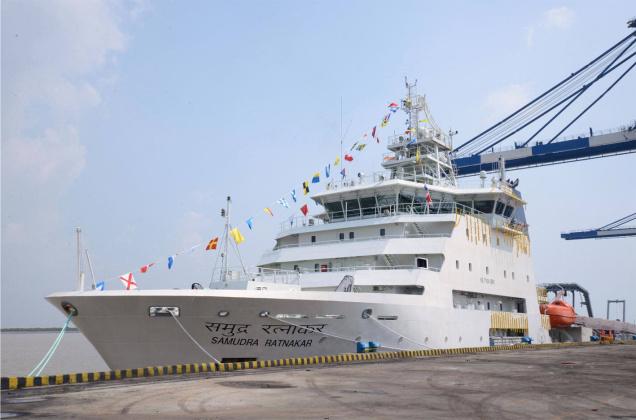Delhi, October 24: The Geological Survey of India (GSI) has launched a deep sea exploration ship ‘RV Samudra Ratnakar’ — a state-of-the-art research vessel designed to meet the fast-growing challenges of the modern geo-scientific oceanographic researches.
The ship is equipped with high-end technologically advanced instruments needed for geological, geophysical and geochemical explorations in offshore areas. It is a multi-tasking and multi-disciplinary ship with modern onboard laboratories, designed to carry out sea-bed mapping, mineral exploration in the deep waters and also research activities.
The ship has been built by Hyundai Heavy Industries (HHI), Ulsan, South Korea, one of the largest ship building yards in the world. Contract to build the ship was signed between GSI and HHI in 2011 and the ship has been built in a record time. After initial sea trials and sea acceptance test of various on-board equipments and its navigational system during May-June 2013, the vessel was delivered at Ulsan in September to GSI. It arrived at Kandla Port on October 8 and will commence marine geo-scientific surveys and exploration activities in January, 2014, after conducting sea trials of certain survey equipment in deep sea up to 4,500 metres and onboard training to the geoscientists of GSI by the Original Equipment Manufacturers (OEM).
RV Samudra Ratnakar is an all-weather ship fitted with Differential Global Positioning System (DGPS), Heading and Motion sensors and Dynamic Positioning System to keep it stationary during coring operations. The vessel is 103.4 metres long, 19.2 metres wide with a draft of six metres. It can continuously sail for 45 days and can cruise at a maximum speed of 14 knots. It can accommodate 73 persons at a time. This number includes 25 geoscientists.
The vessel is fitted with various multi-disciplinary scientific equipment including the Acoustic Doppler Current Profiler (ADCP), Deep and Shallow Multi-beam Sonars, Single Beam Echo sounder, Sub-bottom Profiler, Acoustic Positioning System, Single Streamer Multi-channel Seismic System (960 channels, 6km streamer), Marine magnetometer and gradiometer, Marine gravimeter, Side Scan Sonar, Remotely Operated Vehicle (ROV), Heat-flow measuring system, Current Meter, Conductivity-Temperature-Depth (CTD) system, Synthetic Aperture Sonar (SAS) system and the underwater c amongst others. A robust Marine data management system is in place to integrate and collate data received from various equipments.
With the induction of this multi-disciplinary research vessel, Marine and Coastal Survey Division of GSI is poised to explore the deep ocean and unravel the hitherto-unknown complexities besides searching for deep-sea mineral resources both within the Exclusive Economic Zone (EEZ) of India and international waters. Its endurance capacity and on-board facilities will enable GSI to carryout multi-channel seismic survey, gravity survey, magnetic survey, deep sea imaging, sub-bottom profiling, deep coring and dredging in any part of the world.
The GSI plans to collaborate with other national organisations like the National Centre for Antarctic and Offshore Research (NCAOR), National Institute of Ocean Technology (NIOT), National Institute of Oceanography, Oil and Natural Gas Commission (ONGC) which are working in marine domain and launch exploration for deep sea mineral deposits like poly-metallic nodules, hydrothermal sulphide deposits containing base metals along with gold, cobalt, nickel and silver and cobalt-nickel encrustations. It will help in creation of much valuable database and locating potential zones of mineral deposits for strategic utilisation.
RV Samudra Ratnakar has the capability to explore and identify the favourable zone of accumulation of Gas Hydrates, which are known to be the future source of hydro-carbon energy.

